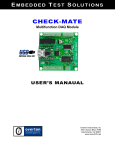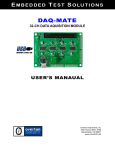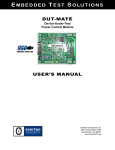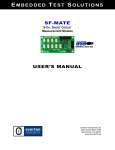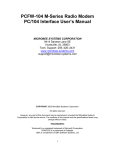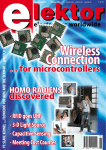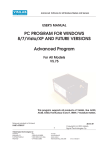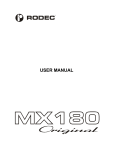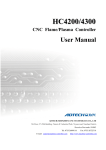Download Check-MATE USER`S MANUAL
Transcript
E M B E D D E D T E S T S O LU T I O N S
C HECK -MATE
Multifunction DAQ Module
USER’S MANAUAL
Overton Instruments, Inc
5431 Auburn Blvd. #196
Sacramento, CA 95841
www.microATE.net
CHECK-MATE USER’S MANUAL
NOTICE
WARNING
WARRENTY
SERVICE POLICY
The information contained in this document is subject to change
without notice. To the extent allowed by local law, Overton Instruments (OI), shall not be liable for errors contained herein or for
incidental or consequential damages in connection with the furnishing, performance, or use of this material. No part of this document may be photocopied, reproduced, or translated to another
language without the prior written consent of OI.
The instrument you have purchased and are about to use may
NOT be an ISOLATED product. This means that it may be susceptible to common mode voltages that could cause damage to
the instrument. SUCH DAMAGE IS NOT COVERED BY THE
PRODUCT’S WARRANTY. Please read the following carefully
before deploying the product. Contact OI for all questions.
OI warrants that this instrument will be free from defects in materials and workmanship under normal use and service for a period of
90 days from the date of shipment. OI obligations under this warranty shall not arise until the defective material is shipped freight
prepaid to OI. The only responsibility of OI under this warranty is
to repair or replace, at it’s discretion and on a free of charge basis, the defective material. This warranty does not extend to products that have been repaired or altered by persons other than OI
employees, or products that have been subjected to misuse, neglect, improper installation, or accident. OVERTON INSTRUMENTS SHALL HAVE NO LIABILITY FOR INCIDENTAL OR
CONSEQUENTIAL DEMAGES OF ANY KIND ARISING OUT OF
THE SALE, INSTALLATION, OR USE OF ITS PRODUCTS.
1. All products returned to OI for service, regardless of warranty
status, must be on a freight-prepaid basis.
2. OI will repair or replace any defective product within 10 days
of its receipt.
3. For in-warranty repairs, OI will return repaired items to buyer
freight prepaid. Out of warranty repairs will be returned with
freight prepaid and added to the service invoice.
Overton Instruments
2
www.dut-mate.com
CHECK-MATE USER’S MANUAL
Table Of Contents
1.0 INTRODUCTION
1.1 Overview
1.2 Highlights
1.3 Specifications
4
4
5
6
2.0 DESCRIPTION
2.1 Board Layout
2.2 Connections
2.3 J6 Consolidated
7
7
8
9
3.0 OPERATION
3.1 Embedded Control
3.1.1 Embedded Configuration
3.1.2 Embedded Programming
3.1.3 Embedded Program Example
3.2 PC Control
3.2.1 PC Programming
3.2.1.1 HyperTerminal
3.2.1.2 Virtual Instrument Panel
3.2.1.3 PC Programming Example
10
10
11
12
13
14
15
15
16
17
APPENDIX A. SERIAL COMMAND SET
18
APPENDIX B. SCHEMATIC
20
APPENDIX C. MECHANICAL DIMENSIONS
21
Overton Instruments
3
www.chk-mate.info
CHECK-MATE USER’S MANUAL
1. Introduction
1.1 Overview
The Check-MATE has all the primary features you expect in a general purpose
data acquisition board, but for a fraction of the cost. It offers 8 single-ended
analog inputs with 12-bit resolution (and a sampling rate of 110KHz). Each of
the analog inputs can be programmed for unipolar or bipolar operation. Likewise, the analog output uses a 12-bit DAC (and operates in unipolar or bipolar
modes). In addition, there are 8 digital input/output lines (which are independently programmable).
The Check-MATE is made available is two versions, a standard model or with a
USB option. The standard model is designed for embedded applications and
provides a simple SPI-bus interface for control by a external microcontroller.
With the USB option, many test solutions can be quickly built by connecting the
Check-MATE to a PC laptop or desktop, and then running our GUI software.
No external power source is required, since power is supplied through the USB
interface. Any either case, easy access to the hardware is made available
through a convenient collection of screw terminal connectors.
.
INPUT
MUX
CHECKCHECK - MATE BLOCK DIAGRAM
12-BIT A/D
CONVERTER
+5V
DC/DC
ANALOG
INPUTS
8 SE
+15V
-15V
USB
INTERFACE
(OPTIONAL)
CONTROL
INTERFACE
12-BIT D/A
CONVERTER
ANALOG
OUTPUT
DIGITAL I/O
EMBEDDED
INTERFACE
Overton Instruments
4
DIGITAL I/O
8-BITS
www.chk-mate.info
CHECK-MATE USER’S MANUAL
1.2 Highlights
BENEFITS
• A flexible, low-cost alternative to expensive PC-based
DAQ cards
• Supports a wide-array of
mix-signal test applications
• Great for embedded solutions - place inside mechanical test fixtures, instrument
boxes or rack-mount enclosures
APPLICATIONS
• Burn-In
FEATURES
• 8-Analog Input Channels
(SE), 12-bit Resolution,
110Khz sample rate
• Engineering
• Depot Repair
• Production Test
• QA/QC Quality Control
• OEM Test Instruments
• 1-Channel, Digital-to-Analog
converter, 12-bit Resolution,
Unipolar/Bipolar modes
• 8 Digital Input/Output Bits,
Independently programmable
• USB or embedded control
interface
• Low Cost
• Compact size, a 2.5” x 2.5”
PCB, with four #4 mounting
holes in each corner (spacers
and hardware included)
Overton Instruments
5
www.chk-mate.info
CHECK-MATE USER’S MANUAL
1.3 Specifications
Analog Inputs
Number of inputs
8 12-bit, single-ended
Input Ranges
0-5V, 0-10V, ±5V, ±10V
Max Sample Rate
110KHz
Nonlinearity
±1LSB, no missing codes
Analog Output
Resolution
12-bit
Range
0-10V, ±10V
Current
±5mA max
Settling Time
4uS max to ±1/2 LSB
Relative Accuracy
±1 LSB
Digital I/O
Number of lines
8 bits, bidirectional
Logic Levels
TTL compatible
Input Control
Embedded
SPI-bus & control logic
USB Interface
Optional USB module
General
Overton Instruments
Power Supply
+5VDC±10%@3mA
Operating Temp
0-50ºC
Dimensions
1.5” x 1.5”
6
www.chk-mate.info
CHECK-MATE USER’S MANUAL
2. I/O Description
2.1 Board Layout
Convenient GND
test point.
J5 - 5 Pin Terminal
Provides access to SPIbus control signals.
J4 - 2 Pin Terminal
- DAC output Pin 1, (+)
Pin 2, (-)
J4 - 9 Pin Terminal
Provides access to
the analog input.
J2 - 10 Pin Terminal
Provides access to
the digital I/O.
LED to indicate
active circuit.
USB Interface
Connectors USB-1 and
USB-2 replaces J1,
and allows connection
to the USB-MATE.
Overton Instruments
J1 - 10 Pin Interface
Provides access for
remote control via an
Embedded controller.
7
www.chk-mate.info
CHECK-MATE USER’S MANUAL
J2
2.2 Connections
J1
Pin
1
2
3
4
5
6
7
8
Name
VCC
SCLK
ADC_CS\
DIN
DAC_CS\
DOUT
DIO_CS\
UNI/BIP\
Dir.
Description
A regulated +5Vdc input .
Current should be limited
to roughly 100mA.
Part of a 3-wire SPI-Bus,
SCLK synchronizes the
serial data transfer for the
DIN and DOUT signals.
A TTL active-low “input’
signal that provides a
chip-select for the ADC.
Part of a 3-wire SPI-Bus,
DIN is serial command
and control data for the,
ADC, DAC and DIO circuits.
Name
Dir.
Description
1
VCC
2
DIO-0
Bit 0
3
DIO-1
Bit 1
4
DIO-2
Bit 2
5
DIO-3
Bit 3
6
DIO-4
Bit 4
7
DIO-5
Bit 5
8
DIO-6
Bit 6
9
DIO-7
Bit 7
10
DGND
+5V Power
Digital Ground
J4
Pin
Name
Dir.
A TTL active-low “input’
signal that provides a
chip-select for the DAC..
1
AI-0
Input CH 0
2
AI-1
Input CH 1
Part of a 3-wire SPI-Bus,
DIN is serial command
and control data for the,
ADC, DAC and DIO circuits.
3
AI-2
Input CH 2
4
AI-2
Input CH 3
5
AI-4
Input CH 4
A TTL active-low “input’
signal that provides a
chip-select for the DIO.
6
AI-5
Input CH 5
7
AI-6
Input CH 6
A TTL active-low “input’
signal that determines
unipolar (1), bipolar (0).
8
AI-7
Input CH 7
9
AGND
Analog Ground
9
DGND
Digital Ground
10
INT
A TTL active-high “input’
signal that indicates a
interrupt from the DIO.
J3
Pin
Name
Dir.
1
DAC-OUT
Voltage Output
2
AGND
Analog Ground
Overton Instruments
Pin
Description
Description
J5
Pin
Name
Dir.
1
VCC
+5V Power
2
SCLK
Part of a 3-wire SPI-Bus.
Use with DIO for possible
external control
7
DIN
Part of a 3-wire SPI-Bus.
Use with DIO for possible
external control
9
DOUT
Part of a 3-wire SPI-Bus.
Use with DIO for possible
external control
10
DGND
Digital Ground
8
Description
www.chk-mate.info
CHECK-MATE USER’S MANUAL
2.3 J6 Consolidated
J6
Overton Instruments
Pin
Name
Dir.
Description
1
VCC
+5V Power
2
DIO-0
Bit 0
3
DIO-1
Bit 1
4
DIO-2
Bit 2
5
DIO-3
Bit 3
6
DIO-4
Bit 4
7
DIO-5
Bit 5
8
DIO-6
Bit 6
9
DIO-7
Bit 7
10
DGND
Digital Ground
11
DAC-OUT
Voltage Output
12
AGND
Analog Ground
13
AI-0
Input CH 0
14
AI-1
Input CH 1
15
AI-2
Input CH 2
16
AI-2
Input CH 3
17
AI-4
Input CH 4
18
AI-5
Input CH 5
19
AI-6
Input CH 6
20
AI-7
Input CH 7
9
www.chk-mate.info
CHECK-MATE USER’S MANUAL
3. Operation
3.1 Embedded Control
In section 3.1.1 (on the next page), the Check-MATE is shown integrated with
other ETS Series components that collectively form a complete Embedded Test
Solution. The diagram shows the Check-MATE being driven by the Mini-MATE.
The Mini-MATE is a low-cost “Embedded Test Controller”, which stores a special
program that is designed to exercise the device-under-test and generate Go/NoGo test results. The Mini-MATE also provides a sizable breadboard area to support the development of custom circuits. Adjacent to the breadboard area is a
series of wire-wrap pins that comprise a goodly amount of general purpose Digital I/O. The schematic below shows the wire-wrap connections which create the
interface between the Mini-MATE and the Check-MATE (J1, 10-pin header connector).
Actually the Check-MATE can be easily driven by most microcontrollers
(including an ARM, AVR, PIC or even a STAMP). When developing an interface
for the Check-MATE, it is recommended the designer start-by reviewing the interface requirements as outlined in the J1 Table (which is provided in the I/O Description section). The next step is to review the Check-MATE schematic, which
is provided in Appendix A. What could be the most challenging aspect of the
design effort is controlling the SPI-bus devices. The Check-MATE contains 3
SPI-bus devices which include an ADC, DAC and DIO circuits. The ADC is a 12bit 8-channel data acquisition chip from Maxim (part number MAX1270). The
DAC is a 12-bit digit-to-analog converter from Maxim (part number MAX5312).
The DIO is an 8-bit device from MicroCHIP (part number MCP230S08). Details
for specific device performance and SPI-bus operation can be found in their respective data sheets. Go to the manufacturers website to download said documents.
Overton Instruments
10
www.chk-mate.info
CHECK-MATE USER’S MANUAL
3.1.1 Embedded Configuration
Device-Under-Test
LOCATOR-II
Mechanical
Test Fixture
B E D - O F - N AI L S
Alpha--ONE
●
RS232 Interface
RS485 Interface
Relay-MATE
Signal Switching
& Routing
Signal Generator
Relay-MATE Interface
Multifunction
DAQ Module
CHECK-MATE
Check-MATE Interface
DUT-MATE
12Vdc
POWER
SUPPY
DUT-MATE Interface
24Vdc
POWER
SOURCE
Power Control Module
T EST C ONTROL U NIT
Panel-MATE
Operator Interface
BREAD-BOARD AREA
MINI-MATE
EMBEDDED
TEST CONTROLLER
Overton Instruments
11
www.chk-mate.info
CHECK-MATE USER’S MANUAL
3.1.2 Embedded Programming
To build-on the PCB board test example (shown in section 3.1.1), we have constructed a demo program using BASCOM. BASCOM is a BASIC language compiler that includes a powerful Windows IDE (Integrated Development Environment), and a full suite of “QuickBASIC” like commands and statements. The
demo program (which is outlined in section 3.2.3), illustrates the ease of controlling the Check-MATE via the Mini-MATE microcontroller.
The program starts by initialing the Mini-MATE for proper operation. You will note
that the BASCOM software provides excellent bit-manipulation capabilities, as
evident by the use of the ALIAS statement. The Mini-MATE (P1 port bits) are
assigned unique label names (i.e., SCLK, DOUT), which are used to support
various Check-MATE functions. In the “Main” program section, the Mini-MATE
receives “high level” serial commands from a host PC, parses them and then
executes accordingly. When (for example), the “CK_CS4” command is entered,
the program selects analog channel number 4. And then when command
“CK_AR1” is entered, the program selects the analog channel range (which is
±5Vdc). Finally, when the command “CK_RA?” is entered, the program call’s
subroutine “Chk_rd_adc(chk_adc_val , Chk_ch , Chk_adc_range)”. This causes
the Check-MATE to take an analog measurement and return the results in a 4
character hexadecimal “ASCII” string.
Independent of the microcontroller hardware or programming language you
choose, the program sequence described above will likely resemble the way you
implement your Check-MATE application. For this reason, we suggest that you
go to our website and download the “Check-MATE.zip” file. In the Documents
folder will contain more extensive examples of routines to control the CheckMATE.
Overton Instruments
12
www.chk-mate.info
CHECK-MATE USER’S MANUAL
3.1.3 Embedded Program Example
' Program: CHECK-MATE Demo
'
---[ Initialization ]---------------------------------------------------------'
$large
$romstart = &H2000
$default Xram
Case "RV":
A_resp = Mid(s , 6 , 1)
If A_resp = "?" Then
Call Chk_rd_adc(chk_adc_val , Chk_ch , Chk_adc_range)
A_str = Str(chk_adc_val)
Print "<" ; A_str ; ">"
Print
Else
Call Print_ic
' invalid command
End If
Dim Chk_adc_word As Word
Dim Chk_adc_val As Single
Dim A_num, A_byte, A_cnt As Byte
Dim Chk_ch, Chk_adc_range, Chk_num, Chk_cnt, Chk_cntl-byte As Byte
Dim S As String * 10, A_resp AS String * 10, A_str AS String * 10
Dim Sf_str As String * 1, Sf_str AS String * 10
Dim A_word as Word
Dim A_val as Single
Dim True As Const 1
Dim False As Const 0
Sclk Alias P1.0
Dout Alias P1.1
Din Alias P1.2
Adc_cs Alias P1.3
Dac_cs Alias P1.4
Dio_cs Alias P1.5
Dac_mode Alias P1.6
Case Else
Call Print_ic
End Select
Else
Call Print_ic
End If
Loop
End
‘ SPI-bus serial clock
‘ SPI-bus serial data output
‘ SPI-bus serial data input
‘ ADC chip select
‘ DAC chip select
‘ DIO chip select
‘ DAC mode, (1) unipolar, (0) bipolar
Declare Sub Print_ic
Declare Sub Print_orr
Declare Sub Print_ur
Declare Sub Print_ok
Declare Sub Chk_rd_adc(chk_adc_val
Byte)
‘ print invalid command
‘ print out-of-range
‘ print under range
‘ print command is OK
As Single , Chk_ch As Byte , Chk_adc_range As
'Set ADC Range
A_resp = Mid(s , 6 , 1)
If A_resp = "?" Then
If Chk_adc_range = Chk_adc_5v Then A_str = "0"
If Chk_adc_range = Chk_adc_10v Then A_str = "1"
If Chk_adc_range = Chk_adc_5v5v Then A_str = "2"
If Chk_adc_range = Chk_adc_10v10v Then A_str = "3"
Print "<" ; A_str ; ">"
Print
Else
A_num = Val(a_resp)
If A_num < 0 Or A_num > 3 Then
Call Print_oor
' out-of-range
Else
If A_num = 0 Then Chk_adc_range = Chk_adc_5v
If A_num = 1 Then Chk_adc_range = Chk_adc_10v
If A_num = 2 Then Chk_adc_range = Chk_adc_5v5v
If A_num = 3 Then Chk_adc_range = Chk_adc_10v10v
End If
End If
'Set ADC channel
Overton Instruments
Sub Print_oor
Print ">>"
End Sub
‘ print out-of-range
Sub Print_ur
Print "<<"
End Sub
‘ print under range
Sub Chk_rd_adc(chk_adc_val As Single , Chk_ch As Byte , Chk_adc_range As Byte)
Chk_adc_val = &H0000
' Select range
If Chk_adc_range = Chk_adc_5v Then Chk_cntl_byte = Chk_adc_5v
If Chk_adc_range = Chk_adc_10v Then Chk_cntl_byte = Chk_adc_10v
If Chk_adc_range = Chk_adc_5v5v Then Chk_cntl_byte = Chk_adc_5v5v
If Chk_adc_range = Chk_adc_10v10v Then Chk_cntl_byte = Chk_adc_10v10v
' Select analog channel
Chk_cntl_byte = Chk_cntl_byte || Chk_ch
Reset Sclk
' take X measurements
For Chk_cnt = 1 To Chk_m_cnts
Chk_adc_word = &H0000
Chk_num = 7
Chk_num_2 = 11
' Select device
Reset Adc_cs
For Chk_cnt_2 = 1 To 24
If Chk_cnt_2 < 9 Then
' Send control byte
Dout = Chk_cntl_byte.chk_num
Set Sclk
Reset Sclk
Decr Chk_num
Elseif Chk_cnt_2 > 12 Then
' Get ADC value
Set Sclk
Reset Sclk
Chk_adc_word.chk_num_2 = Din
Decr Chk_num_2
Else
' dummy clocks
Set Sclk
Reset Sclk
End If
Next Chk_num
' disable device
Set Adc_cs
' collect results
Chk_adc_val = Chk_adc_val + Chk_adc_word
Waitms 1
Next Chk_cnt
' compute average
Chk_adc_val = Chk_adc_val / Chk_m_cnts
Do
Input "Enter command " , S
S = Ucase(s)
A_resp = Left(s , 3)
If A_resp = "CK_" Then
A_resp = Mid(s , 4 , 2)
Select Case A_resp
A_resp = Mid(s , 6 , 1)
If A_resp = "?" Then
A_str = Str(chk_ch)
Print "<" ; A_str ; ">"
Print
Else
A_num = Val(a_resp)
If A_num < 0 Or A_num > 7 Then
Call Print_oor
Else
Chk_ch = A_num
End If
End If
' invalid command
Sub Print_ok ‘ print command is OK
Print "<>"
End Sub
Set Sclk, Dout, Adc_cs, Dac_cs, Dio_cs, Dac_mode ‘ Set to logic ‘1’
Case "SC":
' invalid command
'---[ Sub-Routines]---------------------------------------------------------'
‘ print invalid command
Sub Print_ic
Print "><"
End Sub
---[ Main ]---------------------------------------------------------' In the Main the Operator or Host, is prompted to enter a command. The command is
parsed and then executed if valid. Only two command examples are ‘ shown.
Case "AR":
' read voltage
' out-of-range
End Sub
13
www.chk-mate.info
CHECK-MATE USER’S MANUAL
3.2 PC Control
For those who are more comfortable building traditional PC-based “Automated
Test Equipment” (ATE), the Check-MATE offers many features that are well
suited for that environment as well.
Controlling the Check-MATE from a PC, requires that it be equipped with an optional USB-MATE module. The USB-MATE module contains a USB bridge-chip
and a PIC microcontroller. On the PC side, the USB bridge-chip receives a special set of serial commands. On the Check-MATE side, the PIC controller processes the serial commands and then drives the Check-MATE accordingly. In
order to be recognized by the PC, the USB-MATE module requires a set of Windows’ drivers be installed. To do so, go to “www.Check-MATE.com”, click
“Download”, select the “OI VCP Interface” file and follow the prompts. The letters
VCP stands for “Virtual COM Port”, and is a method by-which the USB interface
can appear to the PC as a standard serial COM port. With the drivers installed
and the USB-MATE connected to the PC, go to the Device Manager (click on
Ports) and verify “OI Serial Interface (COM#)” is included.
The diagram below provides a basic illustration of a PC-driven configuration. As
shown, the Check-MATE is used to stimulate a hybrid module in a test & measurement application. The hybrid module is a mix-signal device that requires Analog I/O, as well as Digital I/O to function properly.
Analog Out
Digital I/O
Analog In
PC Control
HyperTerminal
Control
GUI
Add a USB Hub/s to
drive multiple CheckMATEs and/or other
OI instruments
Overton Instruments
Typical Hybrid Circuit Module
14
www.chk-mate.info
CHECK-MATE USER’S MANUAL
3.2.1 PC Programming
The starting point for developing code to control the Check-MATE, begins with
acquainting yourself with its Serial Command Set. The serial commands are a
sequence of ASCII characters that originate from the PC and are designed to
instruct the Check-MATE to perform specific functions. The complete serial command set is detailed in Appendix B. There are two ways to exercise the serial
commands, (1) using HyperTerminal or (2), run our Virtual Instrument Panel software (Control GUI).
3.2.1.1 HyperTerminal
HyperTerminal is a serial communications program that comes with the Windows OS and is located in the Accessories folder. Use the USB cable to connect the PC to the Check-MATE. Run
HyperTerminal and configure the settings
for 19200 bps, 8 data bits, no parity, 1
stop bit and no flow control. Select the
COM port based on the available COM
port as indicated in the Device Manager
(example shown below).
Press the
‘Enter’ key and the ‘’ prompt should
appear on the screen (as demonstrated
in the example on the right). Refer to the
table in Appendix B, to begin to experiment with the serial commands.
Overton Instruments
15
CM_ID?
<Check_MATE vx.x>
CM_SC6
<>
CM_RV?
<0000>
www.chk-mate.info
CHECK-MATE USER’S MANUAL
3.2.1.2 Virtual Instrument Panel
The Virtual Instrument Panel (or Control GUI), removes the hassle of “manually “
typing ASCII commands and provides the User a more efficient method to interact and control the Check-MATE. Download the panel from our website at
www.check-mate.com, click on downloads and select “Check-Matexxx.exe”.
First Step: The User must
select a COM Port. Refer to
the Device Manage to identify an available COM port.
Second Step: Push the Initialize
button. This will cause the module
to initialize itself and attempt to
establish a communications link.
Third Step: After initializing, the module
should send back a unique ID code. If no
response has occurred within 10 seconds,
the program will time-out , and generate a
No Response message.
This ‘Range’ function selects
(1 of 4) specific analog input
modes.
Each ‘Analog
Input CH’ can be set to a
different range setting.
The ‘Volt Meter’, displays a
voltage measurement
based the current analog
channel and range setting.
The ‘Analog Input CH’ function selects an individual
analog channel (1 to 8).
The ‘ACQUIRE’ function
updates the analog configuration settings, and
displays a measurement
every 100msec.
This ‘Range’ function selects
either Unipolar or Bipolar
operation.
The ‘Output Voltage’ function updates the analog
configuration settings, and
displays a measurement
every 100msec.
The ‘Enable’ function updates
the analog output settings.
This function panel allows
the User to control the DIO
circuit. The top section
provides a tool for setting
the ‘bit’ direction. A blankcircle (indicates input), and
a dot-circle (indicates output). The middle section
includes a set of eight LED’s
(which indicate input status).
The bottom section includes
eight push-button switches
(which allow the setting of
output bits). When the
switch is the out position
(that represents a logic ’0’).
When the switch is in the in
position (that represents a
logic ‘1’).
The ‘DIO Trigger’ function
updates the DIO configuration settings.
The ‘STATUS’ message box
summarizes results of the
serial commands.
Overton Instruments
16
www.chk-mate.info
CHECK-MATE USER’S MANUAL
3.2.1.3 PC Programming Example
//
//
//
//
//
//
//
//
//
//
//
//
//
//
//
//
//
//
//
//
//
Check-MATE programming example in ‘C’
// Set DIO direction & weak pull-up
sprintf (send_data, "%s%s\r", set_dio_dir, "10000000");
PutString(port,send_data);
// send CK_PD10000000
sprintf (send_data, "%s%s\r", set_dio_pullup, "10000000");
PutString(port,send_data);
// send CK_PU10000000
The following program provides a Go/No Go test sequence for testing
a hypothetical electronic module. The electronic module is a mixsignal hybrid device that contains 8 programmable amplifiers. The
electronic module is controlled by a Check-MATE via the DIO lines. DIO
bits 0-3 (select one of 8 DUT amplifiers). DIO bits 4 & 5 (selects the
gain range). DIO bit 6 is active-low (provides a DUT chip-select). DIO
bit 7 is active-high (which indicates the DUT is ready). The outputs of
the DUT amplifiers are connected to the inputs of the Check-MATE analog channels. The objective for the program is to verify each of the 8
amplifiers will perform properly at each gain setting and over a varying
range of input voltage levels. During the test sequence, the program
first selects both the DUT amplifier and the Check-MATE ADC channel. Then the DUT gain is selected and the Check-MATE updates the
DUT by writing the control byte (which asserts the chip-select). The
Check-MATE then reads the DIO-bit-7 to determine if the DUT is
ready. Once the DUT is ready, the Check-MATE will stimulate the
DUT amplifier input by supplying a voltage from the DAC output. To
verify the DUT amplifier, the program reads the Check-MATE analog
channel and determines the PASS/FAIL results.
#define
#define
MSWIN
MSWINDLL
// Execute test sequence
for (dut_ch = 0; dut_ch >= 7; dut_ch++) {
// set check-mate ADC channel & range
sprintf (send_data, "%s%d\r", set_adc_ch, dut_ch);
PutString(port,send_data);
// send CK_SC
sprintf (send_data, "%s%d\r", set_adc_range, 1);
PutString(port,send_data);
// send CK_AR - 0-10Vdc
// exercise DUT gain performance
for (gain_sel = 0; >= 3; gain_sel++) {
if (gain_sel == 0) dut_gain = 4095;
if (gain_sel == 1) dut_gain = 409;
if (gain_sel == 2) dut_gain = 40;
if (gain_sel == 3) dut_gain = 4;
// serial comm libraries from
// www.wcscnet.com
// build dio control byte
a_byte = dut_ch + (gain_sel + 8)
for ( idx = 0; idx <= 7; idx++ ) {
dio_bit[idx] = a_byte % 2;
a_byte = a_byte / 2;
sprintf (dio_byte[idx], "%d", dio_bit[idx]);
}
#include <comm.h>
#include <stdlib.h>
#include <stddio.h>
int stat, port=0, a_byte = 0, a_cnt = 0, int idx = 0;
int dut_ch = 0, dut_gain =0, gain_sel = 0;
int dio_bit[10] = 0;
// Select DUT, gain & amp ch
long value = 0, limit = 0;
sprintf (send_data, "%s%s\r", set_dio_port, dio_byte);
PutString(port,send_data); // send CK_PBxxxxxxxx
char dio_byte[10], dir_byte[10], results[64];
char send_data[64], read_data[64];
char set_adc_range[]
char set_adc_ch[]
char get_adc_volts[]
char set_dac_range[]
char set_dac_out[]
char set_dio_dir[]
char set_dio_pullup[]
char set_dio_port[]
char get_dio_port[]
char get_device_id[]
char master_clear[]
= "CK_AR";
= "CK_SC";
= "CK_RV?";
= "CK_DM";
= "CK_SA";
= "CK_PD";
= "CK_PU";
= "CK_PB";
= "CK_PB?";
= "CK_ID?";
= "CK_MC";
// x1 range
// x10
// x100
// x1000
do {
// set ADC voltage range
// set ADC channel
// read voltage
// set DAC voltage range
// set DAC output voltage
// set DIO port direction
// set DIO port pull-up
// set DIO port write
// get DIO port
// get module ID
// master clear
// Get DIO input - check DUT ready
sprintf (send_data, "%s\r", get_dio_port);
PutString(port,send_data); // send CK_PB?
GetString(port,sizeof(read_data),read_data);
} while (atoi (read_data[1])); // loop while msb = '0', DUT not ready
do {
// Set check-mate DAC output
sprintf (send_data, "%s%04d\r", set_dac_out, dut_gain);
// send CK_SAnnnn
PutString(port,send_data);
// Get check-mate ADC input
main()
{
port=OpenComPort(1,256,64); // Open COM 1, rx_buff = 256 bytes, tx_buff = 64
sprintf (send_data, "%s\r", get_adc_ch);
PutString(port,send_data);
// send CK_SA?
GetString(port,sizeof(read_data),read_data);
for ( idx = 1; idx <= 4; idx++ ) {
results[idx] = read_data[idx];
}
// determine pass/fail results
if ((stat = SetPortCharacteristics(port,BAUD19200,PAR_EVEN,
LENGTH_8,STOPBIT_1,PROT_NONNON)) != RS232ERR_NONE) {
printf("Error #%d setting characteristics\n",stat);
exit(1);
}
// 1 msec ticks
CdrvSetTimerResolution(port,1);
SetTimeout(port,2000);
// 2000 ticks = 2 sec time-out
FlushReceiveBuffer(port);
// clear receiver buffer
FlushTransmitBuffer(port);
// clear transmit buffer
Value = atoi(results);
if (gain_sel == 1) dut_gain = dut_gain * 10;
if (gain_sel == 2) dut_gain = dut_gain * 100;
if (gain_sel == 3) dut_gain = dut_gain * 1000;
limit = asb(value - dut_gain);
if (limit > (0.001 * 4096)) {
printf ("Test Failed - ADC Ch:", "%d", " Gain Range:",
"%d", " Gain Value", "%d", dut_ch, gain_sel, dut_gain);
exit(1);
{
dut_gain--;
// Get device prompt
sprintf (send_data, "%s\r", "");
PutString(port,send_data); // send CR
if ((resp_len = GetString(port,sizeof(read_data),read_data)) == 0); {
printf("Time-out error\n");
exit(1);
}
if (strcmp("-> ", read_data)) {
printf("Incorrect promt\n");
exit(1);
}
// Master Clear
} while (dut_gain != 0);
// De-select DUT
sprintf (send_data, "%s%s\r", set_dio_port, "00000000");
PutString(port,send_data);
// send CK_PB00000000
}
}
printf ("Test Passed");
sprintf (send_data, "%s\r", master_clear);
PutString(port,send_data);
// send CK_MC
}
Overton Instruments
17
www.chk-mate.info
CHECK-MATE USER’S MANUAL
Appendix A. Serial Command Set
To facilitate remote control for the Check-MATE, a USB interface is required. When connected to a host
PC, the USB connection appears as a “Virtual Com Port”, which establishes a serial data communications link between the two. The default protocol is 19200 baud rate, no parity, 1 stop bit and no flow control. The Check-MATE will respond to a unique set of ASCII serial data commands (listed below). The
first three bytes of the command string starts with the prefix ‘CM_’, followed by a code that represents
the actual command. All commands are upper case sensitive and are terminated with a carriage-return.
If the command is valid, the Check-MATE will return either a ‘<>’, or a bracketed result (i.e. ‘<2108>’. If
the Check-MATE receives a carriage-return or line-feed alone (without a command), then a ‘
’ is returned (this response is a “prompt” to signal the Check-MATE is ready). If the Check-MATE detects an
incorrect command then one of three error symbols will be generated, (1) invalid command then a ‘><’ is
returned, (2) a command that is out-of-limits then a ‘>>’ is returned, and (3) a command that prematurely
times-out then a ‘<<‘ is returned. In some cases the error symbol will include a bracketed result (i.e.
‘>1<’), which defines a specific error code.
Command
Function
Response
Description
CM_BRn
Set baud rate code
<n>
Select one of 4 different baud rates by changing -n-code. 0 = 1200, 1 = 2400, 2 = 9600 & 3
= 19200. Baud will remain set. Default code
is 3 (19200).
CM_BR?
Get baud rate code
<n>
Get current baud rate code (-n- is the return
code 0 to 3).
CM_ID?
Get module ID
CM_MR
Maser Reset
<>
Reset & initialize the module
CM_WC
Write
configuration
<>
Store current instrument settings in EEPROM.
Save settings related to the ADC, DAC and
DIO hardware.
CM_RC
Recall
configuration
<>
Retrieve stored instrument settings
CM_SCn
Set ADC channel
<>
Select a ADC voltage channel. The -n- represents a channel number from 1 to 8.
CM_SC?
Get ADC channel
<n>
Get the current ADC voltage channel.
CM_ARn
Set ADC range
<>
Set the ADC range code (-n- is 0 = 0-5Vdc, 1
= 0-10Vdc, 2 = ±5Vdc, and 3 = ±10Vdc).
CM_AR?
Get ADC range
<n>
Get the current ADC range code.
CM_RV?
Get voltage
measurement
CM_CS?
Scan all ADC ch’s
Overton Instruments
<CHECK-MATE vx.x> Get current identification and version number.
<nnnn>
Get a voltage measurement based on the
current ADC channel and range selection. The
measurement contains 4 ASCII bytes representing a 12-bit decimal value (0-4095).
<ch1,ch2,...,ch8>
Measure and output 8 ADC channels. Each
channel contains 4 ASCII bytes representing a
12-bit decimal value (0-4095). A comma ‘,’
separates each channel
18
www.chk-mate.info
CHECK-MATE USER’S MANUAL
Appendix A. Serial Command Set cont.
Command
Function
Response
Description
CM_SAnnnn
Set voltage output
<>
Set the DAC output voltage. The DAC value
is contained in -nnnn-, which comprises a 12bit decimal, 4-byte ASCII string.
CM_SA?
Get voltage output
<nnnn>
Get the current DAC output voltage.
Set (or write) the DIO port direction. The direction byte is represented by eight ASCII
bytes starting with the most-significant-bit (-bleft most) to the least-significant-bit (-b- right
most). A logic ‘1’ is input and ‘0’ is output.
CM_PDbbbbbbbb
Set DIO direction
<>
CM_PD?
Get DIO direction
<bbbbbbbb>
Set (or write) pull-ups on the DIO port inputs.
The pull-up byte is represented by eight ASCII
bytes starting with the most-significant-bit (-bleft most) to the least-significant-bit (-b- right
most). A logic ‘1’ is active and ‘0’ is not.
CM_PUbbbbbbbb
Set weak pull-ups
<>
CM_PU?
Get weak pull-ups
<bbbbbbbb>
Get (or read) the current DIO port pull-up
status.
Set (or write) the DIO port output bits. Depending on the condition of the direction byte,
the output bits are represented by eight ASCII
bytes starting with the most-significant-bit (-bleft most) to the least-significant-bit (-b- right
most). The -b- bit is a logic ‘1’ or ‘0’.
CM_PBbbbbbbbb
Set DIO port
<>
CM_PB?
Get DIO port
<bbbbbbbb>
Overton Instruments
Get (or read) the current DIO port direction
setting.
19
Get (or read) the current DIO port status.
www.chk-mate.info
CHECK-MATE USER’S MANUAL
Appendix B. Schematic
Overton Instruments
20
www.chk-mate.info
CHECK-MATE USER’S MANUAL
Appendix C. Mechanical Dimensions
Overton Instruments
21
www.chk-mate.info





















